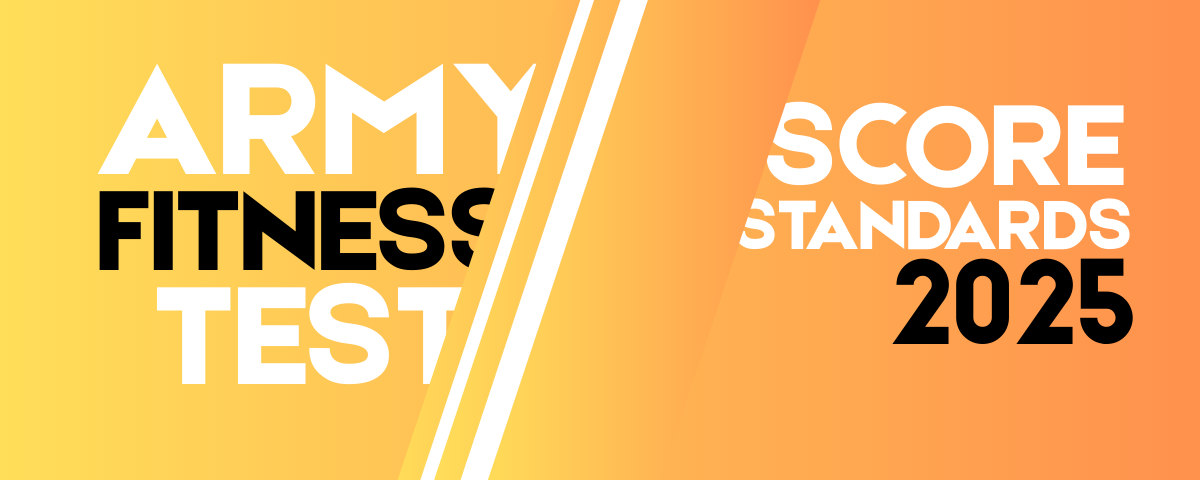
AFT Standards 2025 – Guide to Army Fitness Test Scoring
Are you preparing for the Army Fitness Test (AFT) and need the latest 2025 score standards? Whether you’re a new recruit, active-duty soldier, or veteran aiming to stay in top shape, understanding the AFT scoring scales is crucial for success. This post dissects the official Army Fitness Test (AFT) scoring standards (Approved 15 May 2025; Effective 1 June 2025). These updated standards reflect the Army’s commitment to comprehensive physical readiness. In this detailed guide, we’ll break down each event, provide age- and gender-specific scoring tables, explain how points are calculated, and offer training tips to help you excel.
The AFT, often compared to the previous Army Combat Fitness Test (ACFT), assesses soldiers across multiple dimensions of fitness: strength, power, endurance, and agility. It consists of five core events, each worth up to 100 points, for a maximum total score of 500. To pass, soldiers typically need at least 60 points per event (though always confirm with official Army guidance). Standards vary by age group (from 17-21 to over 62) and gender (male and female), ensuring fairness across demographics.
We’ll Learn in this Army Fitness Test Score Standards – AFT Standards
- What Is the Army Fitness Test?
- How the AFT scoring system works?
- How to read the official tables (step-by-step)?
- Event-by-event explanation (MDL, HRP, SDC, PLK, 2MR + Alternate Events)
- How to calculate your total AFT score ?
- Common pitfalls & tips for publishing / SEO elements
- Training tips to improve each event
- FAQ
Let’s dive in and get you ready to crush the AFT!
What Is the Army Fitness Test (AFT)?
The Army Fitness Test (AFT) is the U.S. Army’s standard physical assessment designed to measure combat readiness and overall fitness. Introduced with updates in 2025, it replaces or evolves from earlier tests like the ACFT by focusing on functional movements that mimic real-world military tasks. The test includes:
- Maximum Deadlift (MDL): Tests lower-body strength with a three-repetition maximum lift.
- Hand-Release Push-Up (HRP): Assesses upper-body endurance in a two-minute timed event.
- Sprint-Drag-Carry (SDC): Evaluates anaerobic capacity and agility through a series of sprints, drags, and carries.
- Plank (PLK): Measures core endurance by holding a straight-line position.
- Two-Mile Run (2MR): Gauges aerobic endurance.
Alternate events are available for the 2MR if a soldier has a temporary or permanent profile restricting running.
Scoring is point-based, with higher performance yielding more points. Age groups include 17-21, 22-26, 27-31, 32-36, 37-41, 42-46, 47-51, 52-56, 57-61, and over 62. Gender distinctions (male and female) account for physiological differences, but some events like the Plank have identical standards.
Searching for “AFT score calculator 2025” or “Army fitness requirements by age”? Use this guide as your go-to resource—we’ve compiled the official tables directly from the 2025 scoring scales PDF.
Check your official Army Fitness Test score with our AFT Calculator — it’s free!
How the AFT scoring system works (Approved 15 May 2025)?
- The AFT uses event-specific score tables that map performance → points. Each event has its own table giving points for specific performances, adjusted by age band and (where applicable) sex.
- Events are scored individually; your total AFT score is the sum of the event points (see “How to calculate” below). The official tables list values from high (100) down to 0 for each age/sex column.
- The document also includes alternate events (2.5-mile walk, 12 km bike, 1 km swim, 5 km row, etc.) that are treated as go/no-go alternatives — these are pass/fail and have different rules than the scored events.
How to read the official AFT tables (MDL, HRP, SDC, PLK, 2MR) ?
Step-by-step reading guide
-
Open the table for the event you’re interested in (e.g., Max Deadlift, Sprint/Drag/Carry). The PDF is organized so each event’s table is clearly labeled.
-
Identify your age band across the top row — age bands are grouped (example: 17–21, 22–26, 27–31, … Over 62).
-
Find the sex column (where the table differentiates male/female) if the event uses sex-based splits. Some tables show a pair of columns for male (M) and female (F) within the age band.
-
Locate your actual performance in the vertical list (reps, pounds, or time). Each row corresponds to a points value — read the row header (Points) to know how many points that performance earns.
-
Repeat for all scored events and add the points to get your total. Use the PDF as the authoritative source for the exact numeric thresholds.
Tip: When converting times to table lookups, always use minutes:seconds format as shown in the PDF (e.g., mm:ss).
AFT (Army Fitness Test) Event by Event
1. Maximum Deadlift (MDL) Scoring Standards
The MDL requires lifting a hex bar as heavy as possible for three consecutive repetitions. It tests raw strength, with weights in pounds (LBS). Maximum points (100) require elite lifts, while 60 points is the minimum passing threshold. A 3-repetition maximal deadlift performed with prescribed technique (bar, belt rules per unit guidance). The MDL table maps the lifted weight (lbs) to points for each age/sex band.
Here’s a summarized table based on the 2025 standards. Values represent the weight needed for each point level; dashes indicate interpolated or non-applicable scores in the official document.
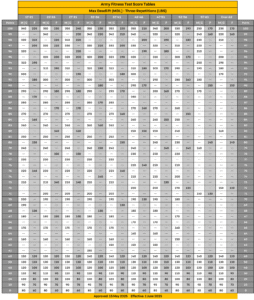
Example: A 25-year-old male lifting 350 lbs earns 100 points; a female in the same age group needs 230 lbs.
How to use the table: Find your age band and sex column, then locate the weight you lifted (or the nearest lower weight row). The corresponding Points row gives your event score.
Training Tip: Focus on progressive overload with deadlifts 2-3 times per week. Incorporate accessory exercises like squats and rows to build a strong posterior chain. Safety and correct setup are critical. Use warm-up sets and follow the official technique.
2. Hand-Release Push-Up (HRP) Scoring Standards
The HRP involves performing as many hand-release push-ups as possible in two minutes. Hands must lift off the ground between reps for validity. This event emphasizes muscular endurance. Repetitions of hand-release push-ups performed correctly during a 2-minute window.
Technique cues: Full chest release to the ground, hands lifted, body straight, full extension on the press. Judges score repetitions that meet the standard.
How to score: Use the HRP lookup table in the PDF — find your age/sex column and the number of correct reps to identify earned points.
Summarized table (reps for points):
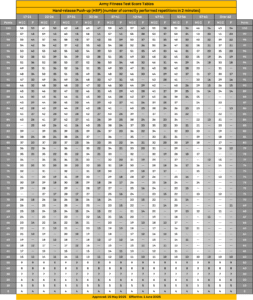
Example: A 30-year-old female completing 48 reps scores 100 points.
Training Tip: Practice timed sets with perfect form. Build up with diamond push-ups and weighted vests for added challenge.
Dominate in the 2025 Army Fitness Push Up test with our Mastering AFT Push Ups guide!
3. Sprint-Drag-Carry (SDC) Scoring Standards
The SDC is a timed event involving five 50-meter shuttles: sprint, drag a sled, lateral shuffle, carry kettlebells, and sprint again. Faster times earn higher points.
Summarized table (times in minutes:seconds for points):
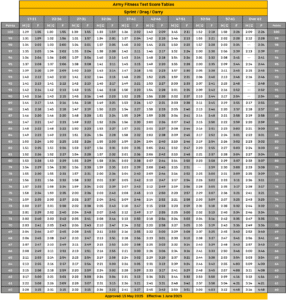
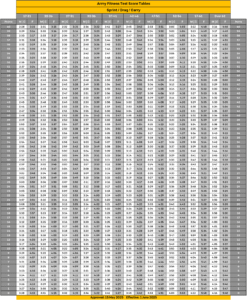
Example: A 40-year-old male finishing in 2:02 earns 80 points.
Training Tip: Incorporate HIIT workouts with sled drags and kettlebell carries. Time your practice runs to track progress. Practice transitions, grip changes, and short-burst conditioning. Small time improvements can translate to several points.
4. Plank (PLK) Scoring Standards
The Plank requires holding a forearm plank position with proper form for as long as possible. Unlike other events, standards are identical for males and females across all ages. A static core hold in a straightline position for time (minutes:seconds).
How to score: Maintain the required straightline posture; any loss of position ends the attempt. Read the Plank table in the PDF for exact thresholds.
Note: Standards decrease slightly with age, but remain uniform gender-wise. For example, over 62 still requires 3:20 for 100 points.
Summarized table (hold time in minutes:seconds):
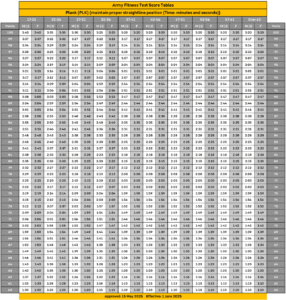
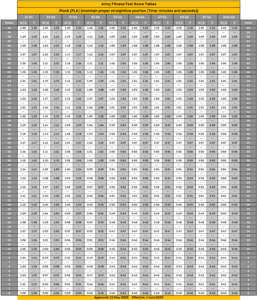
Training Tip: Build core strength with daily planks, progressing from 30 seconds to beyond 3 minutes. Add variations like side planks for balance.
5. Two-Mile Run (2MR) Scoring Standards
The 2MR is a timed run on a flat course, testing cardiovascular endurance (or approved alternate endurance events for soldier limitations). Slower times deduct points.
Alternate (Go/No-Go) events: If a soldier uses an alternate event (2.5-mile walk, 12 km bike, 1 km swim, 5 km row), these are listed as go/no-go standards rather than scored points. See the Alternate Events table for pass times.
Summarized table (times for points):
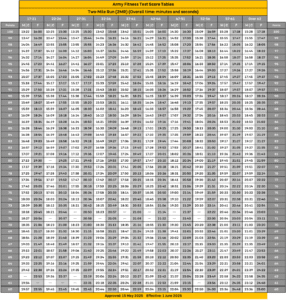
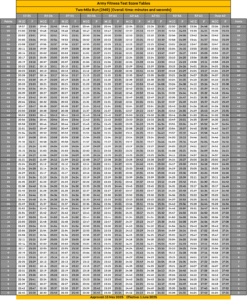
Example: A 50-year-old female running 20:34 earns 80 points.
Training Tip: Follow a running program with interval training. Aim for 3-4 runs per week, incorporating hills for strength.
Check out 2 Mile Run (2MR) test guide to dominate the event and boost your 2025 Army Fitness Test (AFT) score!
Alternate Aerobic Events (Go/No-Go)
If unable to run due to injury, soldiers can opt for alternates. These are pass/fail based on completing the distance under the time limit.

Note: These are maximum allowable times for a “Go” (pass).
How to Calculate Your AFT Score ?
Add points from all five events. Aim for 300+ for a strong passing score. Use online AFT score calculator for precision, inputting your age, gender, and performance.
Method
- Get your score for each event from the tables.
- Add them up:
Total Score = MDL_points + HRP_points + SDC_points + PLK_points + 2MR_points
Example
- Deadlift: 160 lbs = 70 pts
- Push-ups: 45 reps = 75 pts
- SDC: 2:05 = 80 pts
- Plank: 3:20 = 85 pts
- Run: 15:30 = 82 pts
Total = 392 points
Training Tips to Ace the AFT in 2025
- Build a Balanced Routine: Train 4-5 days/week, mixing strength, cardio, and mobility.
- Track Progress: Use apps like MyFitnessPal or Army-specific trackers.
- Nutrition and Recovery: Fuel with protein-rich meals and prioritize sleep.
- Common Mistakes: Avoid overtraining; focus on form to prevent injury.
AFT Score Standards FAQs
- What’s the difference between AFT and ACFT? The AFT appears to streamline the ACFT by potentially omitting the Standing Power Throw, emphasizing core events.
- Do standards change for combat roles? The PDF uses “C F” possibly for combat female, but values align with general male/female distinctions.
- Where to find official updates? Check army.mil or your unit for the latest.
Preparing for the Army Fitness Test? Bookmark this guide for your 2025 AFT score standards reference. Share your scores in the comments, and stay fit! If you need personalized training plans, consult a certified trainer.
Leave a Reply